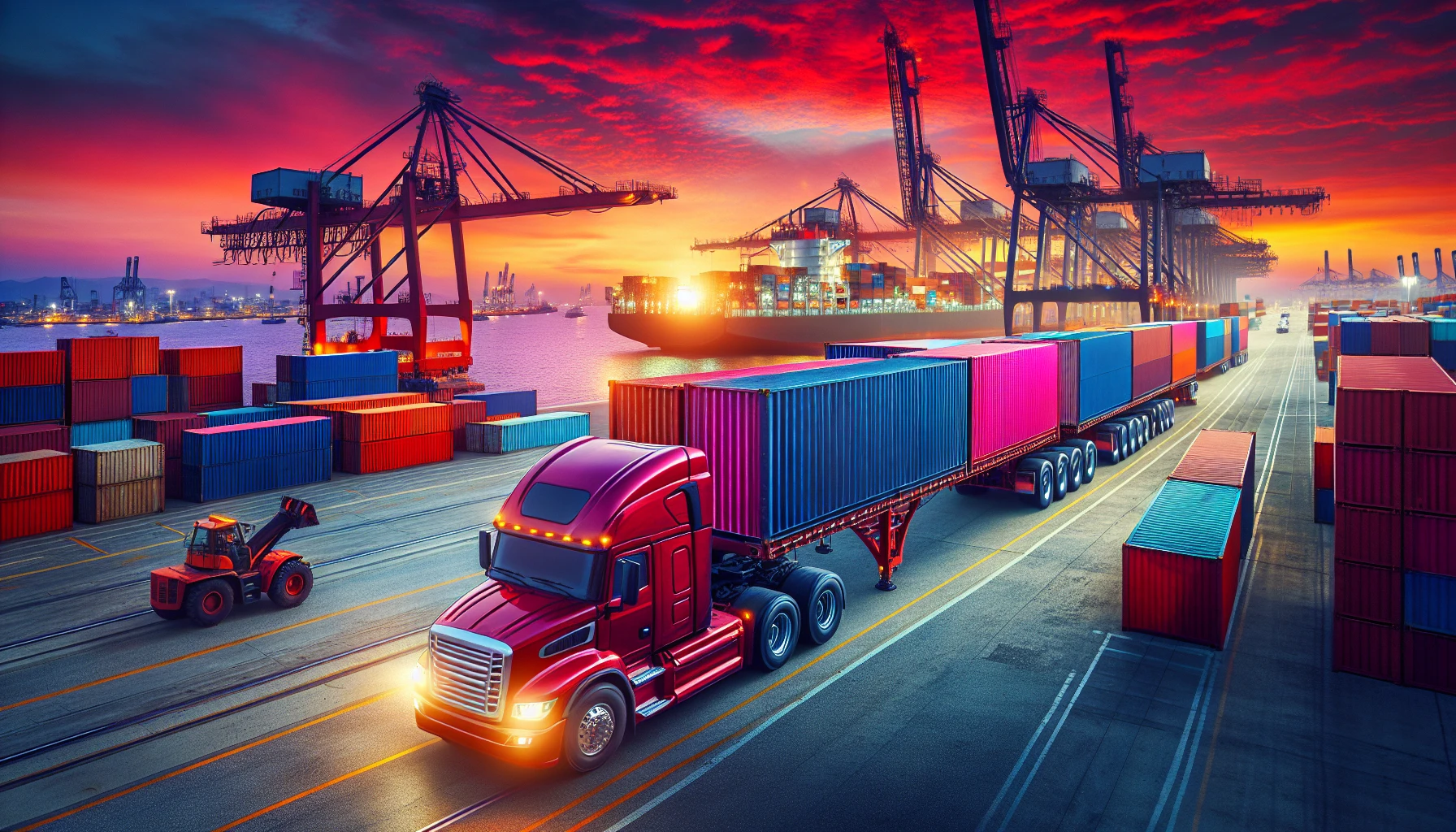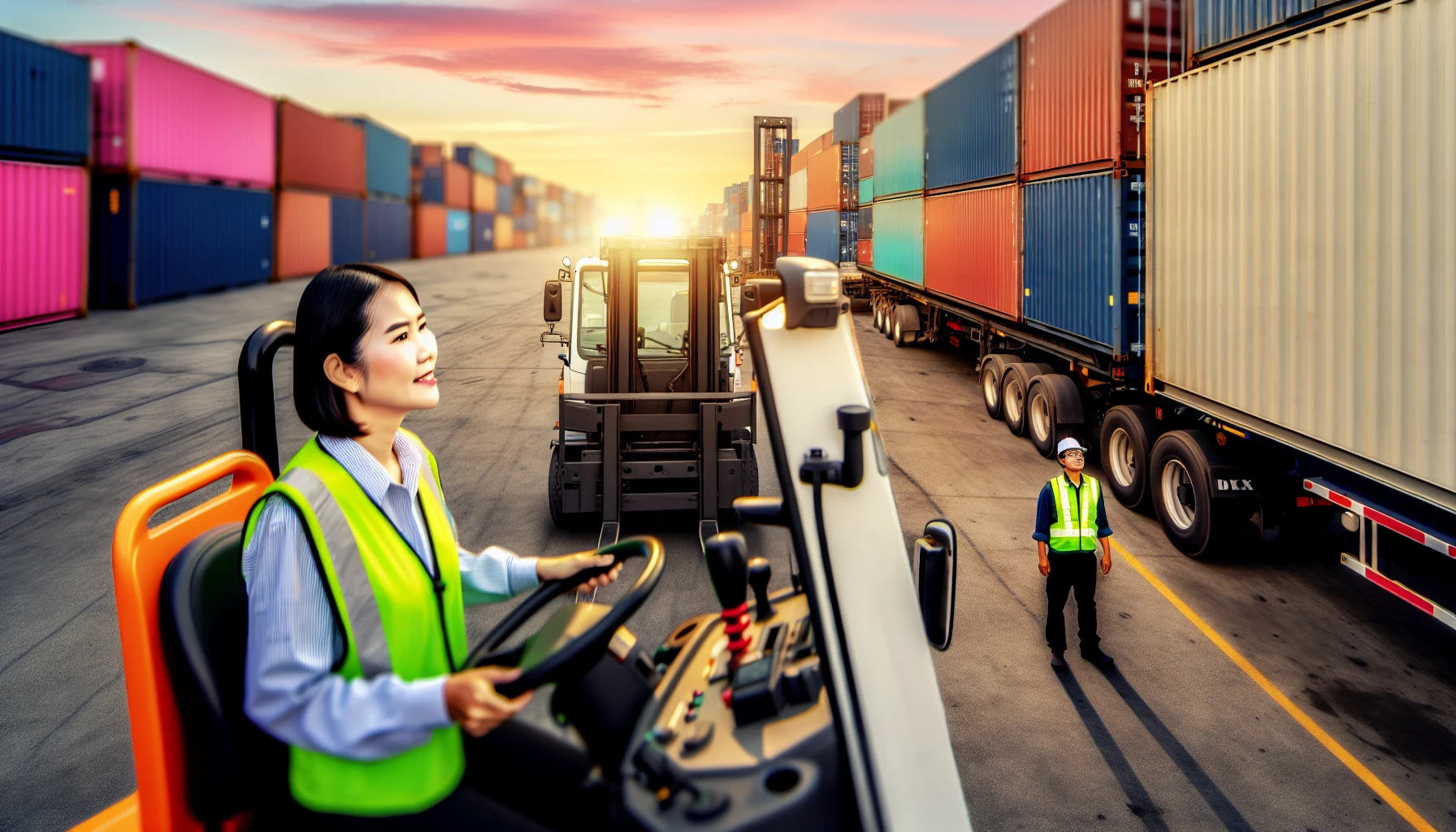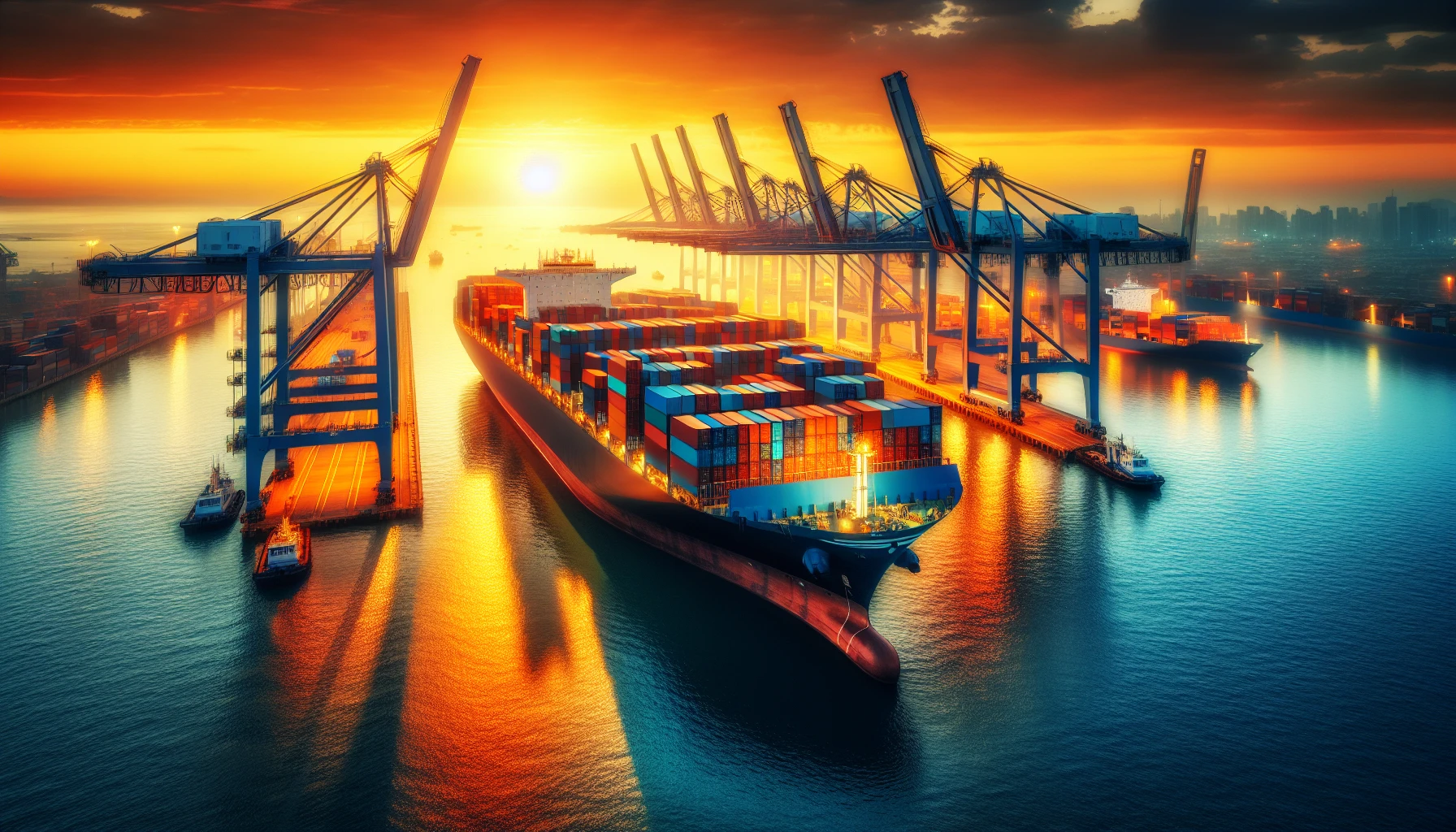As our world becomes increasingly interconnected, the importance of efficient and reliable cargo transportation has never been more critical. What is container drayage? It plays a vital role in global trade, connecting various modes of transportation and ensuring seamless cargo movement. In this blog, we’ll explore the ins and outs of container drayage, its impact on the supply chain, and how it continues to shape the future of freight transport.
Key Takeaways
- Container drayage is a critical part of the freight shipping industry, enabling efficient cargo transportation between ports and rail terminals.
- Key players in container drayage operations include service providers, 3PLs and freight brokers who collaborate to ensure smooth movement of goods.
- To optimize efficiency businesses must adhere to best practices such as choosing reliable partners, complying with documentation requirements & utilizing scheduling strategies & tracking systems.
Understanding Container Drayage

Within the complex logistics environment of today, container drayage is a significant service that moves goods over short distances, linking various transportation methods such as ships, trucks, and trains. In fact, approximately 95% of manufactured freight is shipped via containers.
Container drayage guarantees efficient cargo transport between ports, rail yards, warehouses, and other sites, making it essential to choose a reliable container drayage service.
It plays a significant part in the freight shipping industry as a rail hub.
Intermodal shipping refers to the process of transporting goods via multiple modes of transport, and it is heavily reliant on container drayage services. Container drayage serves as the bridge between various intermodal points, ensuring the smooth transition of goods between different modes of transportation at an intermodal hub. The demand for intermodal transport, which includes intermodal shipping, has increased significantly in the wake of the COVID-19 pandemic, leading to a rise in the need for efficient container drayage services.
The Basics of Container Drayage
Container drayage primarily involves the use of trucks for short-distance transportation of goods between ports, rail terminals, and warehouses. This process facilitates the transition between intermodal shipping long hauls, particularly when transitioning between different modes of transportation. For instance, a container arriving by ship may need to be transported to a train or delivered to a warehouse.
Trucks are the predominant mode of transportation for container drayage. Choosing a dependable container drayage company can significantly enhance the transportation process’s efficiency and timeliness. They can help with:
- Navigating delays or port congestion
- Offering competitive rates
- Handling communication and planning with various stakeholders, such as shippers, consignees, container yards, steamship lines, and railroads.
Key Players in Container Drayage
In the world of container drayage, there are several key players responsible for ensuring the smooth movement of cargo. These include drayage service providers, third-party logistics providers (3PLs), and freight brokers.
Drayage service providers are directly responsible for transporting containers from the port to the container yard or consignee’s facility. 3PLs, on the other hand, facilitate the paperwork and requirements for container drayage while offering supplementary services like shipment tracking and management. Freight brokers, similar to 3PLs, negotiate shipping rates, vet carriers, track and manage shipments, and oversee time-sensitive tasks to ensure shipments remain on schedule.
Collaborating with these key players can significantly enhance the efficiency and reliability of container drayage operations.
The Different Types of Drayage Services

There are various types of drayage services designed to cater to specific needs in the supply chain process. The Intermodal Association of North America has identified six different classifications of drayage:
- Pier drayage
- Import drayage
- Export drayage
- Intra-carrier drayage
- Inter-carrier drayage
- Time-sensitive drayage
We will examine some of the most common types of drayage services and their unique characteristics in the subsequent sections.
Pier Drayage
Pier drayage refers to the transportation of cargo from a port to a nearby warehouse or distribution center. It plays a critical role in moving cargo from ships to their final inland destinations. Some of the equipment used for pier drayage includes specialized trucks and containers, such as flat racks or open-top containers, depending on the type of cargo being transported. In addition to pier drayage, door to door drayage services are also available for seamless end-to-end transportation solutions.
Factors such as the quantity of cargo being delivered, the distance traveled, and the degree of handling needed typically determine the cost of pier drayage services. Understanding the factors affecting pier drayage costs is important when choosing a service provider, as additional charges may include fuel surcharges, toll charges, and chassis fees.
Import Drayage
Import drayage focuses on the transportation of imported goods from a port to a warehouse or distribution center. It is essential for ensuring the timely delivery of imported items to their final destinations. However, import drayage can encounter various challenges, such as:
- Incorrect documentation
- Inaccurate payments
- Misclassification of goods
- Port congestion
- Equipment shortages
- Vessel schedules
To overcome these challenges and ensure a smooth import drayage process, it’s essential to maintain proper documentation, work with reliable service providers, and stay updated with the latest regulations and requirements. By addressing these challenges, businesses can ensure the efficient movement of their imported goods through the supply chain.
Export Drayage
Export drayage involves moving goods from a warehouse or distribution center to a port for export. It is a crucial part of the supply chain process, as it ensures that products reach their intended overseas markets. Export drayage can be associated with various challenges, such as:
- Incorrect documentation
- Inaccurate payments
- Misclassification of goods
- Port congestion
- Equipment shortages
- Vessel schedules
By addressing these challenges and ensuring proper coordination, businesses can optimize their export drayage operations and guarantee the timely delivery of their goods to overseas markets. By working with reliable service providers and staying updated with regulations and requirements, businesses can ensure the smooth movement of their goods through the export drayage process.
The Importance of Container Drayage in Today’s Supply Chain

Container drayage significantly contributes to global trade, promoting international trade and commerce by enabling efficient goods movement between ships, trucks, and trains and facilitating the smooth flow of goods in the global supply chain. Moreover, with over 90% of freight being transported in containers, container drayage has become an essential component of the supply chain management.
In addition to its impact on global trade, container drayage also helps address current supply chain challenges, such as port congestion, container shortages, and limited truck capacity. By optimizing container drayage operations and working with reliable service providers, businesses can overcome these challenges and ensure the timely delivery of goods to their final destinations.
Impact on Global Trade
Drayage services, including shuttle drayage, drayage shipping, and expedited drayage, are essential for facilitating efficient cargo movement and contributing to the growth of global trade. As container drayage optimizes intermodal connectivity and reduces transportation costs, it enables the efficient transportation of goods from ports to their final destinations, stimulating economic growth and supporting the expansion of global logistics markets.
Furthermore, container drayage has had a significant effect on global trade trends, such as e-commerce and technological advancements. For instance, the rise of e-commerce has led to an increase in the movement of goods from ports to distribution and fulfillment centers, with container drayage playing a crucial role in providing transportation for these items. Technological advancements, such as GPS tracking and digital platforms, have also improved the speed and accuracy of container drayage operations, thereby facilitating more efficient global trade.
Addressing Current Challenges
Container drayage plays a crucial role in mitigating port congestion by facilitating the removal of containers from the docks, thus enabling ports to process more shipments daily. Moreover, the increased demand for drayage services resulting from container shortages has led to the implementation of strategies such as long-term, guaranteed container counts, short-term leases at off-site locations, and offering both brokerage services and warehousing opportunities to tackle the container shortage.
Furthermore, container drayage helps address the issue of limited truck capacity in freight transportation by providing an efficient means of transporting shipping containers between ports, rail yards, and distribution centers, reducing congestion at ports and making the most of available truck capacity. By implementing effective container drayage practices, businesses can overcome current supply chain challenges and ensure the efficient movement of goods.
Equipment and Technology in Container Drayage

Modern equipment and technology have significantly enhanced the efficiency and reliability of container drayage services. From various types and sizes of shipping containers to advanced tracking systems, these innovations have revolutionized the way goods are transported, ensuring timely delivery and improved visibility throughout the supply chain process.
Shipping Containers
Shipping containers come in various types and sizes to accommodate different cargo requirements during intermodal transportation. These containers are typically constructed from corrugated steel and are designed for intermodal transportation, as they can be shipped on a boat, by rail, or even on a truck.
Standard shipping containers used for container drayage typically measure 20 feet, 40 feet, or 45 feet, with carrying capacities of up to 28 tons of cargo for the 20-foot and 40-foot containers. These containers play a vital role in facilitating the transportation of goods between different stages of the shipping process, ensuring the efficient delivery of cargo to its final destination.
Tracking Systems
Advanced tracking systems have revolutionized container drayage by enabling real-time monitoring of cargo movement during transportation. Some benefits of these systems include:
- GPS tracking devices and IoT sensors provide real-time insights into the location and status of containers
- Drayage providers and truckers can gain visibility into the movement of containers
- Operations can be optimized based on real-time data
These advancements have greatly improved efficiency and effectiveness in container drayage.
Implementing tracking systems in container drayage can result in improved logistics efficiency, increased cargo security, and reduced dwell and demurrage costs. By leveraging state-of-the-art tracking technology, businesses can streamline their container drayage operations, ensuring the timely and efficient movement of goods throughout the supply chain.
Best Practices for Container Drayage

Adopting best practices can enhance container drayage operations and guarantee a seamless supply chain process. From selecting a reliable drayage service provider to maintaining proper documentation and compliance, businesses must adopt strategies that enhance their container drayage efficiency.
In the following sections, we will discuss some of the key best practices for container drayage.
Choosing a Drayage Service Provider
Selecting a reliable and experienced drayage service provider is crucial for the successful movement of cargo. Factors to consider when choosing a drayage service provider include:
- Years of experience
- Cost
- Communication
- Transparency
- Accountability
- Flexibility
- Technology
- Reputation
By carefully evaluating potential service providers and considering these factors, businesses can ensure they choose the best partner for their container drayage needs. A dependable service provider can not only facilitate the efficient and timely movement of containers but also provide assistance with navigating delays or port congestion and offer the best rates.
Documentation and Compliance
Proper documentation and compliance with regulations are essential to avoid delays and penalties in container drayage. Businesses should maintain essential documentation such as:
- Bill of Lading (B/L)
- Packing List
- Commercial Invoice
- Certificate of Origin
Additionally, staying updated with regulations and complying with applicable trucking compliance requirements is essential for smooth container drayage operations.
Utilizing advanced technology and partnering with reliable service providers can help ensure compliance with container drayage regulations. Following best practices for loading, stowing, and securing freight containers is necessary to ensure safety and compliance with hazardous material regulations.
Scheduling and Coordination
Effective scheduling and coordination between all parties involved in container drayage can minimize disruptions and ensure timely cargo delivery. To achieve efficient scheduling and coordination, businesses can implement the following strategies:
- Synchronized scheduling
- Truck appointment systems
- Empties management
- Gate management
These strategies will help streamline operations and improve overall efficiency in container drayage.
Utilizing tools and software such as transportation management systems (TMS), trucking dispatch software, and applications providing information on loads, schedules, and routes can further enhance scheduling and coordination in container drayage. By adopting these strategies, businesses can optimize their container drayage operations, ensuring the efficient movement of goods through the supply chain.
Learning Container Drayage as a Freight Broker
Freight brokers can enhance their service to clients and broaden their service offerings by learning about container drayage. Comprehending the complexities of container drayage allows freight brokers to offer comprehensive solutions to their clients, guaranteeing the supply chain’s timely and efficient movement of goods.
Freightskills is a premium provider of Drayage Education
Freightskills offers comprehensive education on container drayage, helping freight brokers enhance their knowledge and skills in the field. By learning about container drayage from a premium provider like Freightskills, freight brokers can gain valuable insights into the industry, improving their ability to serve their clients and expand their service offerings.
Freightskills provides a range of drayage courses, such as freight broker training, which can equip freight brokers with the knowledge and expertise required to excel in the container drayage industry. By enrolling in Freightskills’ education programs, freight brokers can stay updated on the latest trends, regulations, and best practices in container drayage, ensuring their success in the field.
Summary
In conclusion, container drayage is an essential component of the global supply chain, connecting different modes of transportation and ensuring the efficient movement of goods. By understanding the intricacies of container drayage and implementing best practices, businesses can optimize their operations, overcome supply chain challenges, and contribute to the growth of global trade. As the world becomes increasingly interconnected, the significance of container drayage will continue to grow, shaping the future of freight transport.
Frequently Asked Questions
What is the difference between shipping and drayage?
Drayage is the process of transporting goods by truck for short-haul distances, while intermodal shipping involves using multiple transportation methods to move freight over longer distances, with drayage included as one of the modes.
What is an example of a drayage?
An example of drayage is a truck transferring cargo in a shipping container between a port and a railyard.
What is the main difference between container drayage and intermodal service?
The main difference between container drayage and intermodal service is that the former relies solely on trucking while the latter utilizes multiple modes of transport, such as sea, rail, and truck.
What is the primary purpose of container drayage in the supply chain?
Container drayage is an important part of the supply chain, allowing for efficient cargo movement by facilitating transport of goods between other modes of transportation over short distances.
How does container drayage contribute to global trade growth?
Container drayage optimizes intermodal connectivity, reduces transportation costs, and facilitates the efficient transportation of goods, driving global trade growth.
tential fees, learning how to execute a drayage move properly can prove to be a valuable asset to your and your customer’s business.
Visit this link to join the Freight Skills Academy
FREE DOWNLOAD: Get our Drayage Checklist to help you quote and understand drayage shipments
Click here to claim it now
SAVE 10% On Your DATONE Subscription through our Link HERE:
* Offer valid for new subscribers of DAT only
P.S. Whenever you’re ready… here is how I can help you grow your Freight Brokerage:
1. Watch my free Webinar
It’s the roadmap to growing your freight brokerage past 6-figures: https://freightskills.com/webinar-registration/
2. Join the Freight Broker Network and connect with Brokers who are scaling too. It’s our new Facebook community where smart broker’s learn to get more income, impact, and independence.: https://freightskills.com/facebook-join/
